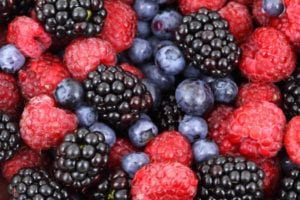Written by Greg Arnold, DC, CSCS. A 12 year study on 807 participants over age 65, showed a 30% greater risk of death in those with the lowest blood levels of polyphenols, compared to the highest levels. Polyphenols can be obtained from fruits, vegetables, legumes, tea, honey, and supplements.
 Polyphenols are antioxidants found in fruits and vegetables. They have an abundance of healthy-promoting properties that include grape polyphenols for blood pressure health (1) and olive polyphenols for cholesterol health (2) and bone health (3).
Polyphenols are antioxidants found in fruits and vegetables. They have an abundance of healthy-promoting properties that include grape polyphenols for blood pressure health (1) and olive polyphenols for cholesterol health (2) and bone health (3).
Now a new study (4) suggests polyphenols may help with lifespan. In the study, 807 men and women over 65 years of age and participating in the InChianti study (5) provided urinary samples to measure for levels of polyphenols. They also completed dietary questionnaires on their dietary intake of polyphenols (6) and were followed for an average of 12 years.
During the 12 years of follow-up, 274 participants (34% of the subjects) died. The researchers found that those still living in the study had 13.9% higher total urinary polyphenols when the study began versus those who died during the 12 years of follow-up (163 vs. 143 milligrams gallic acid equivalents per day, p = 0.07). This resulted in a 30% reduced risk of death for those with the highest urinary levels of polyphenols versus those with the lowest urinary levels of polyphenols (greater than 173 versus less than 123 mg gallic acid equivalents per day, p = 0.045).
Dietary intake of polyphenols, however, was not associated with a decreased risk of death. This did not pose a problem for the researchers, as it showed the unreliability of dietary recall questionnaires (7). Urinary polyphenol measurements are truly objective (8) and have been validated in two previous studies (9, 10).
The mechanisms by which polyphenols elicit these healthful effects “are still unknown but may be due to their cardiovascular-protective and anti-cancer effects because cardiovascular disease and cancer are the two main causes of mortality in this section of the population (11, 12).” For the researches, “Total urinary polyphenols is an independent risk factor for mortality among community-dwelling older adults, suggesting that high dietary intake of polyphenols may be associated with longevity.”
Source: Zamora-Ros, Raul, et al. “High concentrations of a urinary biomarker of polyphenol intake are associated with decreased mortality in older adults.” The Journal of nutrition 143.9 (2013): 1445-1450.
© 2013 American Society for Nutrition
Posted November 19, 2013.
Greg Arnold is a Chiropractic Physician practicing in Hauppauge, NY. You can contact Dr. Arnold directly by emailing him at PitchingDoc@msn.com or visiting his web site at www.PitchingDoc.com
References:
- Barona J. Grape Polyphenols Reduce Blood Pressure and Increase Flow-Mediated Vasodilation in Men with Metabolic Syndrome. J Nutr 2012; 142(9):1626-1632.
- de la Torre-Carbot K. Elevated Circulating LDL Phenol Levels in Men Who Consumed Virgin Rather Than Refined Olive Oil Are Associated with Less Oxidation of Plasma LDL. Jou Nutr 2010; 140 (3): 501-508.
- Santiago-Mora R. Oleuropein enhances osteoblastogenesis and inhibits adipogenesis: the effect on differentiation in stem cells derived from bone marrow. Osteop Int 2010. DOI: 10.1007/s00198-010-1270-xb.
- Zamora-Ros R. High concentrations of a urinary biomarker of polyphenol intake are associated with decreased mortality in older adults. J Nutr 2013 Sep;143(9):1445-50. doi: 10.3945/jn.113.177121. Epub 2013 Jun 26.
- Ferrucci L, Bandinelli S, Benvenuti E, Di Iorio A, Macchi C, Harris TB, Guralnik JM. Subsystems contributing to the decline in ability to walk: bridging the gap between epidemiology and geriatric practice in the InCHIANTI study. J Am Geriatr Soc. 2000;48:1618–25.
- Zamora-Ros R, Knaze V, Luj´an-Barroso L, Romieu I, Scalbert A, Slimani N, Hjarta°ker A, Engeset D, Skeie G, Overvad K, et al. Differences in dietary intakes, food sources, and determinants of total flavonoids between Mediterranean and non-Mediterranean countries participating in the European Prospective Investigation into Cancer and Nutrition (EPIC) study. Br J Nutr. 2013;109:1498–507.
- Spencer JP, Abd El Mohsen MM, Minihane AM, Mathers JC. Biomarkers of the intake of dietary polyphenols: strengths, limitations and application in nutrition research. Br J Nutr. 2008;99:12–22.
- Jenab M, Slimani N, Bictash M, Ferrari P, Bingham SA. Biomarkers in nutritional epidemiology: applications, needs and new horizons. Hum Genet. 2009;125:507–25.
- Lamuela-Raventos RM. Rapid Folin-Ciocalteu method using microtiter 96-well plate cartridges for solid phase extraction to assess urinary total phenolic compounds, as a biomarker of total polyphenols intake. Anal Chim Acta. 2009;634:54–60.
- Zamora-Ros R, Rabassa M, Cherubini A, Urpi-Sarda M, Llorach R, Bandinelli S, Ferrucci L, Andres-Lacueva C. Comparison of 24-h volume and creatinine-corrected total urinary polyphenol as a biomarker of total dietary polyphenols in the Invecchiare in Chianti study. Anal Chim Acta. 2011;704:110–5.
- Nijveldt RJ. Flavonoids: a review of probable mechanisms of action and potential applications. Am J Clin Nutr. 2001;74:418–25.
- Arts IC, Hollman PC. Polyphenols and disease risk in epidemiologic studies. Am J Clin Nutr. 2005;81:S317–25.
